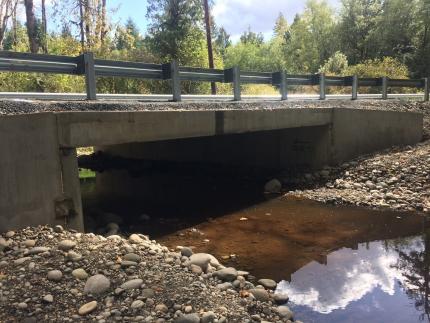ARCHIVED NEWS RELEASE
This document is provided for archival purposes only. Archived documents do not reflect current WDFW regulations or policy and may contain factual inaccuracies.
News release
Susan Zemek, Washington State Recreation and Conservation Office, 360-902-3081
Rachel Blomker, Washington Department of Fish and Wildlife, 360-701-3101
OLYMPIA – Coho salmon will have an easier time swimming up the Middle Fork of the Newaukum River near Chehalis this fall, thanks to a project funded by the Brian Abbott Fish Barrier Removal Board. This is the first two miles of more than 201 miles of streams slated to open across the state after barriers to fish passage are removed.
The expanded habitat in the Middle Fork of the Newaukum River marks the first completed project of the board’s $46.2 million investment in more than 69 projects statewide since the board was created in 2014. Of those projects, 47% will open access for migrating chinook salmon, a critical part of the southern resident orca diet. Projects are funded and planned in 20 counties across the state, with the next few wrapping up in Asotin and Clallam counties later this year.

In partnership with the Washington State Recreation and Conservation Office and Washington Department of Fish and Wildlife (WDFW), the board funds corrections to culverts, which are large pipes or other structures that carry streams under roads. Culverts are the most common barriers to migrating fish because they can be too high for fish to reach, too small to handle large and fast river flows, or too steep for fish to swim through.
“This first project is an incredible achievement for the board, the people of Washington, and our environment,” said Kaleen Cottingham, director of the Washington State Recreation and Conservation Office. “In addition to improving access for fish, these projects also will enhance the roads that cross over them, support public safety, and protect our communities from flooding.”
“The projects funded by the Brian Abbott Fish Barrier Removal Board are building on previous fish passage investments by local governments, landowners, and the Washington State Department of Transportation,” said Tom Jameson, WDFW fish passage manager and chair of the Brian Abbott Fish Barrier Removal Board. “We appreciate the Legislature’s continued support of these salmon and orca recovery efforts.”
Created by the Legislature in 2014, the Brian Abbott Fish Barrier Removal Board coordinates the removal of barriers that block salmon and steelhead from reaching prime spawning and rearing habitat on state, local, tribal and private land. Funding comes from the sale of state bonds.
The board is named after Brian Abbott, who was a life-long fisherman, avid salmon recovery leader, and spearheaded creation of the board while serving as executive coordinator of the Governor’s Salmon Recovery Office.
Other board members include representatives from the Washington Departments of Transportation and Natural Resources, Washington State Association of Counties, Association of Washington Cities, the Governor’s Salmon Recovery Office, the Confederated Tribes and Bands of the Yakama Nation, the Confederated Tribes of the Colville Reservation and the salmon recovery Council of Regions.
MEDIA OPPORTUNITY
What: Photo and interview opportunities with Director Cottingham, Board Chair Tom Jameson, and other speakers as part of Middle Fork Newaukum Fish Passage celebration event. See the full agenda at https://bit.ly/32Jayrz.
When: Wednesday, Nov. 20 at 1 p.m.
Where: Remarks at Carlisle Lake Park, followed by opportunities to view the Middle Fork Newaukum Fish project and salmon swimming upstream. Map for reference.